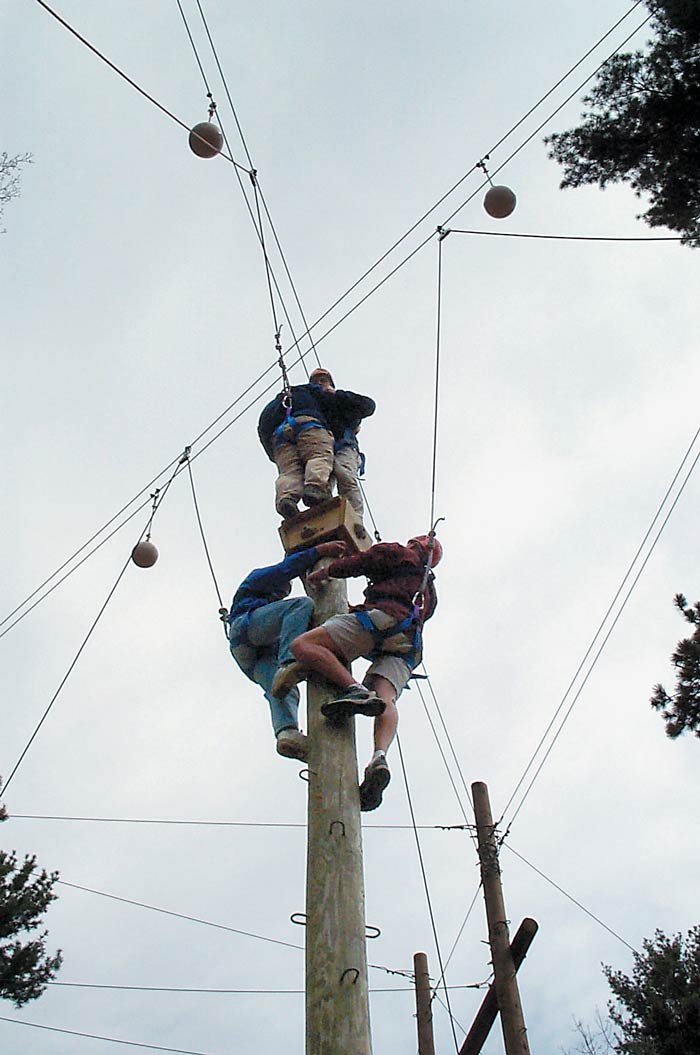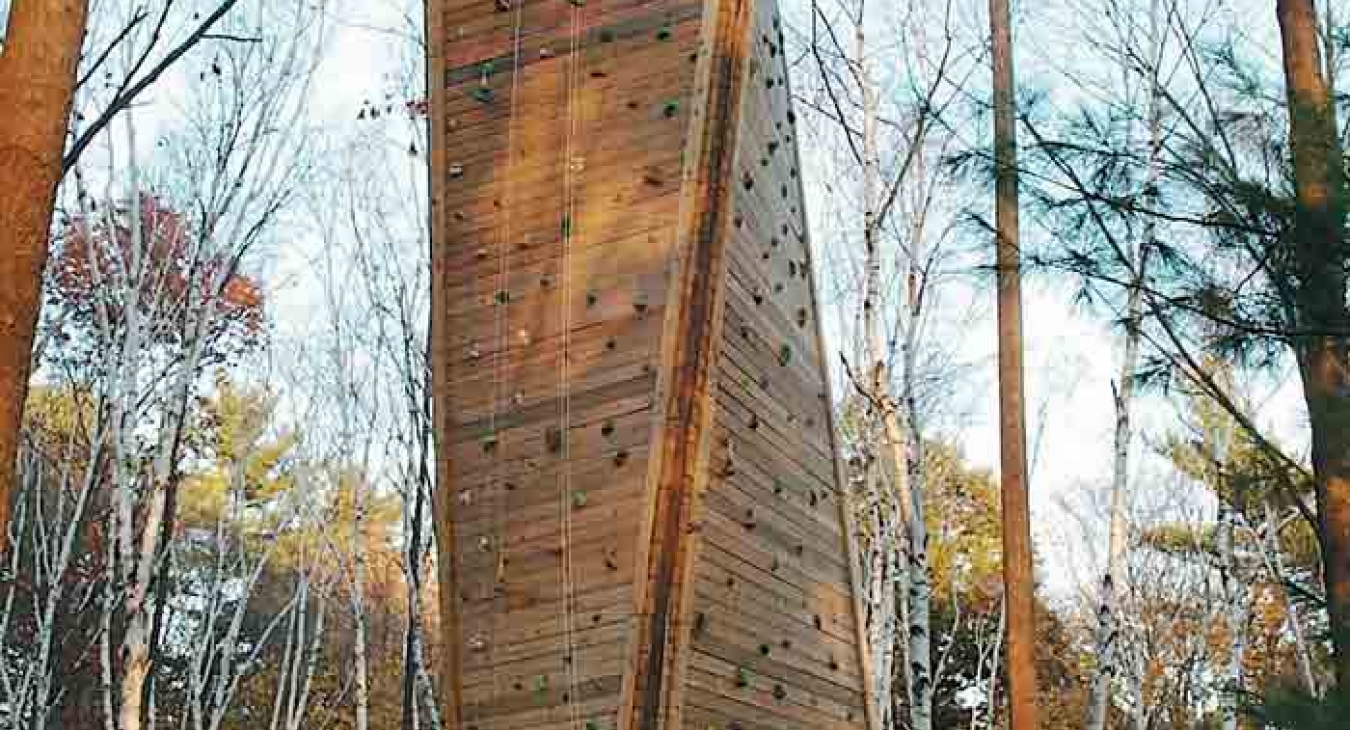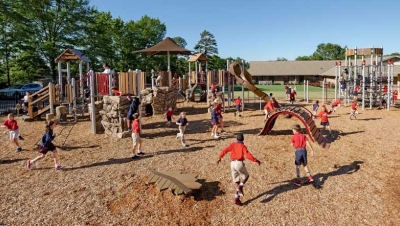Learning Through Challenge
Tightropes taut between telephone poles; belay and repel lines; 30-foot platforms: it looks more like a military obstacle course than physical education equipment. But these obstacle courses are part of physical education at schools nationwide.
Confidence courses are becoming a popular alternative for competitive games and sports. They may look like recreational equipment, but challenge courses are more than just fun and games.
“A challenging course is an excellent teaching tool,” says Sylvia Dresser, president of the Association for Challenge Course Technology in Martin, Mich. “There is very specific training attached to the activities.”
Challenge courses use barriers such as height and distance as catalysts not only for physical movement but also for improving interpersonal skills.
“The participants learn team-building, cooperation, communication and those types of skills,” says Randy Smith, president of Inner Quest, based in Purcellville, Va. “When you work through these types of activities, you do a certain amount of problem-solving. “Sometimes your idea doesn’t work and another kid’s idea does work. All that’s important is the team’s success.”
Many of the activities allow the students to figure out their own means of accomplishing a task, such as moving all the team members from one platform to another. The students may walk the tightrope, move across hand-over-hand, or whatever creative means they think of to do the job.
Ann Dapolito, physical education director at North Rose-Wolcott Central Schools in New York, has been overseeing challenge courses as part of the schools’ PE program since its installation in May 2002.
“It’s a great program,” Dapolito says. “It stresses a lot of cooperation and working together. For some, being taught that in PE was new to them. After the first week, they started to buy into the idea.”
Dapolito’s set-ups include series of utility poles with lines suspended between them for belay activities and platforms for climbing and other high activities. Some of the platforms are more than 20 feet in the air; others are only two feet off the ground.
Mohawk Walk, an activity used at North Rose-Wolcott, requires a series of trees that have thin tightrope wire strung between them in a zigzag pattern about two feet off the ground.
“The kids work together to get the tightrope walker across,” Dapolito says. “Some have good balance; others might hang onto the other teammates.”
Another activity used at North Rose-Wolcott helps students develop trust in their classmates. One student climbs up to a platform five feet off the ground. Below, near the platform, the rest of the class stands in two parallel rows and joins hands to form a safety net. The student on the platform falls backwards into the arms of the students on the ground.
Participants in challenge courses can compete against one another as teams or compete against their own abilities to accomplish tasks as one big team.
“It helps students identify the limit of their comfort zone,” says Lisa Hunt, a trainer, and consultant with Beverly, Mass.-based Project Adventure.
Hunt believes that the benefits aren’t limited to increased confidence in a child’s own physical ability.
“If kids can climb up higher than they thought they could, maybe they’ll raise their hands in math class when they aren’t sure if they have the right answer. It’s exciting to see that interplay.”
Introducing a challenge course to a school puts everyone on an equal plane, whether students are athletically gifted or not.
“It engages kids who aren’t active in other sports,” Hunt says. “PE is not everyone’s favorite class.” Some children are not as competitive as others, for example, and challenge course activities can be difficult.
“The higher activities tend toward self-awareness and not competitiveness,” Smith says. “Most of the activities are non-competitive.”
Competitive team sports also tend to segregate students into cliques. Because challenge courses incorporate many different types of activities and skills, students can find ways to shine.
“With challenge courses, there is no ‘in’ and ‘out’ crowd,” Hunt says. “You can explore your limits more naturally.”
Traditional sports and PE activities tend to shut out less physically talented students, a situation which contributes to poor health.
According to the U.S. Surgeon General (http://fitness.gov/adoles.html), “only 19 percent of all high school students are physically active for 20 minutes or more, five days a week, in physical education classes.”

“PE has never been more important, nor has using alternative ways to reach more students been more important,” Hunt says. “Challenge courses meet those needs in a unique way.”
The Surgeon General also found that “well designed school-based interventions directed at increasing physical activity in physical education classes have been shown to be effective.”
As with any new equipment, proving a challenge course’s value and validity can be difficult.
“Talk about how you want your PE curriculum and show how challenge courses will meet those outcomes,” Hunt says.
By creating clear objectives for PE class, it is easier to show how a challenge course can fulfill the students’ needs.
Being introduced to a whole new means of PE can be unsettling, especially when parents, faculty, and staff are used to more traditional sports. Because they may be unfamiliar with challenge courses, it may seem better to encourage physical activity that keeps the children’s feet planted safely on the ground.
“The first perception is about safety,” Hunt says. “Anytime you deal with something new, you deal with questions of safety.”
John Lazarus, owner of Northeast Adventure, LLC in Burlington, Conn., also hears many questions about safety.
“Statistics are showing much lower incidents of injury than traditional team sports,” he says.
A 20-year study conducted by Project Adventure indicates an occurrence of only “6.22 injuries per 1 million hours of program exposure,” which includes both adults and children. The study compares this rate with that of basketball (2,650) and soccer (4,500), both competitive sports widely used in school settings.
“Challenge course activities are supervised activities,” Lazarus says. “They require supervision to facilitate the activity. In team sports, participants may be given a task but not be supervised.”
For example, some members of a football team may be told to go charge the tackle dummies, but no one will be watching because the coach is busy training other members of the team for other tasks.
The high elements on challenge courses usually do not have footholds until 12-15 feet up—too high for kids to reach. This can prevent trouble for kids who are lingering on school property unsupervised.
Like the television program Fear Factor (NBC), participants are asked to do things that seem dangerous, but they are also provided with safety equipment such as helmets, harnesses, and ropes. The students are also guided by trained personnel to make sure they do not attempt anything unsafe.
“We try to put participants in environments of perceived risk,” Lazarus says. “If the environment is 30 feet off the ground, teachers are trained to keep the participants safe.”
Smith agrees that trained instructors are essential to safety.
“The instructors are very well trained,” he says. “The reason these activities are so safe is that the action is very closely supervised.”
Project Adventure averages 12-15 days of training for teachers.
The Association for Challenge Course Technology sets safety standards for building and maintaining equipment and training staff.
“We have a peer review program to look at vendors and see how they do in relationship to our standard,” Dresser says.
The list of vendors is on the association’s Web site.
The non-competitive nature of challenge course activities may also help keep students safer. Instead of trying dangerous moves to win at all costs, students are more likely to try working together with their teammates to succeed.
In addition to safety, the challenge course’s validity as PE equipment is often questioned because of its novelty. After all, football, basketball, and baseball have been proved to be sports students enjoy. Buying equipment of which students quickly tire would be a tremendous waste of budget funds.
But challenge courses are not limited in their usage. Like children’s blocks or modeling clay, challenge courses hold endless creative possibilities for constructive activity.
With just a few pieces of equipment, instructors can lead a large number of varied activities. Unlike some sports equipment, challenge courses can be used for more and more complex activities as the students learn.

“You use one activity to build to the other one,” Smith says. “The best implementation of a program is to develop a kindergarten through twelfth-grade program so it’s a continuous process.”
Dapolito has set up North Rose-Wolcott’s program in just that fashion.
“There is little conversation that a climber has to have with the spotter,” she says. “That same conversation will carry them through high school.”
“The young kids’ eyes get big when you tell them that. They’re learning at an early age about responsibility and cooperating with those they are working with.”
When the climber says, “Climber ready,” the spotter replies, “Spotter ready. Climb away,” to signal his preparedness.
Challenge courses are also flexible on a day-to-day basis to meet the demands of hectic schedules.
“It’s easy to fit challenge course activities into a PE curriculum,” Smith says, “from the standpoint of the amount of time you have. You can do several simpler activities in a 45-minute time period, or, for a more complex activity, you could do just one.”
The cost of a challenge course varies greatly depending upon how many elements it includes and how complex each element is, but a simple course can still yield great results.
“The most effective programs are those with the smallest budgets,” Lazarus says, “because those programs have facilitators so interested in the program that they focus more on the creativity of the program activities and can run a goal-based program.”
Lazarus says such a program could run about $2,000, which would include a couple different elements. The average course runs about $15,000 to $25,000 including low and high elements, safety equipment and training.
Project Adventure’s low elements cost about $400 to $1,000 apiece and high elements cost $800 to $2,000 apiece, plus installation costs. The different courses used at North Rose-Wolcott Central Schools cost $84,000 and they serve kindergarten through twelfth grade.
Sometimes buying bigger isn’t better if the program is not as widely implemented as it is at North Rose-Wolcott.
“Some schools spend $80,000 and have a wide range of physical activities to put people through,” Lazarus says, “but the dollar per meaningful experience is typically better with smaller budgets.
“People tend to rely more on the structure than the facilitator.”
Hunt also finds that to be true.
“For us, a challenge course is just a piece of equipment,” she says. “What makes it effective is when it is intentionally integrated into a curriculum.
“Some schools have wanted us to install a $45,000 challenge course but have no idea how they are going to use it. It’s how you use it that makes all the difference.”
The use of challenge courses at camps has altered the public perception of them, which can complicate the process of buying a program.
“Challenge courses are beginning to be used for recreational purposes, so kids in educational settings don’t understand what they are used for,” Dresser says. “It affects kids who play on the equipment and then come to use it at school.”
School challenge courses should never be used by unsupervised children and never outside of a structured PE class. When challenge courses are viewed as equipment for a PE program, and not on the same plane as a jungle gym or slides, then their expense will seem much more valid.
In the 19th century, most people lived on farms and by necessity, children worked alongside their parents performing manual chores. In the Information Age, both work and recreation are spent sedentarily. Challenge courses can provide an exciting new way to interest children in physical activity while enhancing their teamwork and problem-solving skills.


















Add new comment